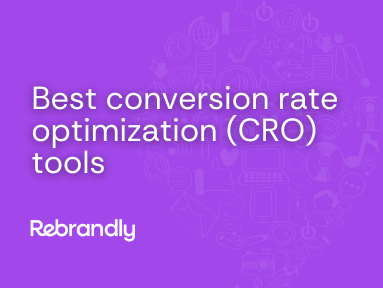SMS marketing: Your complete guide to mobile messaging success
September 12, 2025

SMS marketing delivers results that other channels simply can’t match. With a 98% open rate compared to email’s 26.8%, text messages reach customers when and where they’re most likely to engage.
The numbers are clear: SMS works. The market is projected to surpass $37.45 billion by 2031, reflecting how businesses are shifting budgets toward direct mobile communication. Texting has moved from a supplementary channel to a core marketing strategy.
This guide covers everything you need to build SMS campaigns that drive real results. Whether you’re launching your first text campaign or scaling an existing program, you’ll learn:
- What SMS marketing is and why it works
- Different types of SMS campaigns
- Best practices for personalization, timing, and compliance
- How to measure performance and calculate ROI
- Tools and technologies for scalable SMS strategies
We’ll start with core definitions and benefits, then move into the specific tactics your team can use to build effective SMS campaigns.
What is SMS marketing?
SMS marketing is a digital marketing strategy that uses text messages to communicate with customers on their mobile devices. Companies send promotional offers, order updates, appointment reminders, and other business communications directly to subscribers’ phones.
This channel works because it delivers messages instantly to a device people check constantly. Unlike email or social media, text messages appear directly on the phone screen and typically get read within minutes of delivery.
What makes SMS different from other communication channels is its directness and immediacy. Text messages don’t get lost in crowded inboxes or buried by social media algorithms. The 160-character limit forces clear, actionable messaging that recipients can understand and respond to quickly.
There are three primary categories of SMS marketing:
- Promotional SMS: Sale announcements, discount codes, product launches, and event invitations designed to drive traffic and conversions
- Transactional SMS: Shipping notifications, appointment reminders, and security alerts that provide essential customer updates
- Conversational SMS: Personalized recommendations, support responses, and account offers that build one-to-one customer relationships
Each type serves different business objectives, but all benefit from SMS’s core advantages: high open rates, immediate delivery, and direct customer access. Unlike paid advertising or social media, SMS doesn’t depend on algorithms or organic reach—your message goes straight to the customer.
Modern SMS platforms have made text marketing more accessible and trackable than ever before. With the right tools and strategy, SMS can become one of your most effective customer communication channels.
Why SMS marketing works
Mobile marketing works because it reaches customers where they already spend their time—on their phones. Text messages are concise, high-priority communications that people check immediately.
But those aren’t the only benefits of SMS marketing:
The psychology behind SMS success
SMS works because it aligns with how people naturally use their phones. Several factors make text messages more effective than other marketing channels:
- Personal space: SMS arrives on a device people keep close and check frequently
- Less competition: Texts appear directly on screen, not hidden in a cluttered inbox
- Built-in urgency: People expect text messages to be timely and important
- Forced clarity: The 160-character limit eliminates fluff and creates actionable messages
People treat text messages as priority communications, which means your marketing messages get the attention they deserve… when you use the channel strategically.
SMS marketing’s business impact
According to Forbes, SMS can generate $71 in revenue for every $1 invested. This ROI advantage comes from SMS’s unique position in the marketing mix—it delivers results without the high costs of paid advertising or the low engagement rates of email marketing.
SMS campaigns help you reach large audiences while keeping costs low. Unlike other channels that require significant ad spend or complex creative assets, bulk SMS messages achieve strong results with minimal investment.
5 types of SMS marketing campaigns
SMS marketing campaigns fall into five main categories, each serving different business needs. Some drive immediate sales, others build long-term relationships, and some keep customers informed about important account activity. Understanding these different campaign types helps you choose the right approach for your goals.
Let’s break down the most common types of SMS marketing campaigns businesses use today.
1. Transactional SMS campaigns
Transactional SMS messages are triggered by customer actions and deliver time-sensitive updates. These messages keep customers informed about important account activity and answer questions before they need to contact support.
Some examples of transactional SMS messages include:
- Order confirmations and shipping updates
- Appointment reminders
- Security alerts and two-factor authentication codes
- Account notifications, like password changes or credit card updates
These messages improve customer experience by providing information when people need it most. They reduce support inquiries while building trust through proactive communication.
2. Promotional SMS campaigns
Promotional SMS messages drive conversions, engagement, and awareness. They work best for time-limited offers and urgent announcements that benefit from immediate attention.
Some examples of promotional SMS messages include:
- Flash sales and exclusive discount codes
- New product launches
- Event invitations
- Holiday and seasonal promotions
Promotional campaigns take advantage of SMS’s immediacy to create urgency and drive action during critical sales periods.
3. Customer service and support messaging
Customer service messages keep customers informed and supported throughout their experience with your brand. These messages reduce support tickets by providing proactive information.
Some examples include:
- Support ticket updates
- Knowledge base articles and FAQ responses
- Survey and feedback requests
- Follow-ups after customer service interactions
These messages reduce support costs while improving customer satisfaction and building trust through helpful communication.
4. Re-engagement and retention messages
Re-engagement campaigns help you reconnect with inactive customers and maintain loyalty among existing ones. These targeted messages address specific behaviors or lifecycle stages.
Examples include:
- Cart abandonment reminders
- Loyalty program updates
- Win-back offers for lapsed customers
- Personalized recommendations based on past purchases
When used strategically, these campaigns strengthen customer relationships and increase lifetime value.
5. Automated SMS workflows
Automated workflows deliver timely, relevant messages based on customer behavior and lifecycle events. These systems create personalized experiences without manual intervention.
Examples include:
- Welcome series for new subscribers
- Post-purchase follow-ups
- Birthday or anniversary greetings
- Behavior-triggered campaigns based on engagement patterns
These five campaign types work together to create a complete SMS marketing strategy that supports both customer acquisition and retention.
SMS marketing strategies
Effective text message marketing requires matching your messages to your audience’s behaviors and preferences. Successful campaigns move beyond random promotions to create coordinated, personalized experiences that build customer relationships.
Define clear SMS marketing campaign objectives
Like any digital marketing strategy, SMS campaigns need transparent, data-driven objectives. These best practices guide your team, set achievable goals, and give purpose to every message.
Start by defining what you want from SMS campaigns. Create specific objectives such as: “We want our SMS marketing campaigns to increase account demo requests by 10% over the next 3 months.” This statement includes all the requisite information you need to clarify objectives for your team. It has a specific metric you want to impact, the change in that metric you want to achieve, and a timeline for when you’ll assess the success of the campaign.
Segment your audience for targeted messaging
Segmentation makes SMS marketing more effective by helping you send relevant messages to the right people. When you divide your audience into specific groups based on shared characteristics, your messages feel personal rather than generic.
You can segment your SMS audience in four main ways:
- Demographic segmentation: Age, gender, job role, or income level
- Behavioral targeting: Past purchases, website activity, or app usage
- Geographic segmentation: Location-based offers or local events
- Engagement level: Active users, occasional buyers, or inactive subscribers
Proper segmentation ensures your messages resonate with each group’s specific needs and interests, leading to higher open rates, more clicks, and increased conversions.
Personalize messages for more relevant content
Once you’ve segmented your audience, you can personalize the messages they receive with content that matches their specific interests and needs.
Examples of SMS content personalization include:
- Dynamic content insertion: Using names or product names in the message
- Location-based messaging: Promoting nearby stores or regional events
- Purchase history integration: Suggesting relevant products or upsells
- Preference-based customization: Using stated interests or observed behaviors
Timing matters just as much as content. The best time to send SMS messages varies, but it is when your audience is most likely to engage based on their behavior patterns and time zones.
Integrate SMS with your existing marketing funnel
SMS works best as part of a coordinated customer journey. When you align messaging across platforms, you create consistent experiences that build trust and drive higher conversion rates.
Examples of effective cross-channel coordination include:
- Email and SMS coordination: Reinforcing sales promotions and appointment reminders
- Social media and SMS synchronization: Building connections across platforms
- Website and app integration: Following up on customer actions like cart abandonment
- Consistent messaging: Ensuring your brand voice remains the same across all channels
This integrated approach helps customers move smoothly through your marketing funnel while receiving the right message at the right time.
For tactics that go beyond the basics, explore our guide to driving SMS customer engagement for actionable ways to increase loyalty and response rates.
SMS marketing best practices and compliance
Effective SMS marketing campaigns require following best practices that cover legal requirements, message formatting, and technical considerations. Following these guidelines protects your brand while improving engagement and ROI.
Stay legally compliant
Ensure your messages comply with all applicable legal requirements, particularly those outlined in the Telephone Consumer Protection Act (TCPA). Here’s what that includes:
- Getting explicit opt-in consent before sending marketing messages
- Including a simple opt-out method, like “Reply STOP to unsubscribe.”
- Keeping records of consent for each contact in case of audits or disputes
It’s also essential to consider GDPR compliance regulations whenever subscribers in the European Union (EU) receive your campaigns.
Following these rules protects your business from fines and helps you build a list of genuinely interested subscribers.
Recipients must first opt in to receive messages from your company. This process ensures you’re not sending unwanted messages to your audience and helps cut down on the potential for marking your message as spam. The Telephone Consumer Protection Act (TCPA) privacy laws outline additional laws and regulations for marketing communication via text message.
Maintain clean subscriber lists
When it comes to SMS marketing lists, quality beats quantity. Subscribers who actively opt in engage more and report spam less.
Use website pop-ups, checkout pages, or social media to gather opt-ins with clear value propositions, such as discounts or early access. Remove inactive subscribers regularly—a smaller, engaged list outperforms a large, uninterested one.
Don’t assume someone wants texts just because they gave you their phone number. Use specific language when collecting opt-ins: “Sign up to receive text alerts and offers.” Confirm subscriptions with a double opt-in and always include an unsubscribe option.
Calibrate message timing and frequency
Timing is everything in SMS marketing. People open text messages almost instantly—90% of recipients react within just three minutes. That immediacy is a double-edged sword: it can lead to higher engagement or feel disruptive if the timing is off.
Well-timed SMS messages can significantly enhance open rates, click-through rates, and conversions. However, sending messages at the wrong time will lead to frustrated recipients, lower engagement, and even spam complaints, which can damage deliverability and undermine future SMS efforts altogether.
Best practices for timing your SMS marketing:
- Send during regular business hours: 10:00 a.m. – 8:00 p.m.
- Leverage analytics to localize send times in your SMS subscribers’ time zone and country
- Consider different weekday and weekend patterns
- Avoid sending multiple SMS messages on the same day unless you have set that expectation with subscribers in advance
Craft engaging SMS content
You only have 160 characters to make an impression, so every word counts. Make your messages clear, direct, and action-oriented:
- Lead with value: “Flash Sale: 20% off sitewide today only!”
- Be direct: “Tap to learn more”
- Create urgency: “Ends at midnight!”
Every message needs a strong call to action—otherwise, even perfectly written content won’t get results. Use action words that tell people exactly what to do: “Shop now,” “Get your code,” or “Claim your offer.”
Push people to act immediately with urgency language. “Today only” or “Hurry, ends soon” gives them a reason to act right now instead of putting it off. And make it easy—one click should do it. If people have to hunt for links or navigate multiple steps, they won’t bother.
Ensure technical and delivery success
Successful SMS campaigns require a reliable technical infrastructure. Key technical considerations include:
- Using reliable link management to avoid broken links or redirect issues
- Monitoring carrier-specific rules to avoid content that might get flagged or blocked
- Formatting messages for readability across all devices
- Managing message frequency to prevent recipient fatigue (aim for value, not volume)
These technical elements work together to ensure your messages reach subscribers and function properly when they arrive.
Maintain brand consistency
SMS messages should reflect your brand identity even within the 160-character limit. Maintain consistency through:
- Consistent tone and language that matches your other communications
- Branded short links that reflect your domain and build trust
- Visual elements like MMS or rich media, when appropriate
- Coordinated messaging across email, SMS, and social channels
SMS becomes a natural extension of your brand when you maintain a consistent voice and presentation across all customer communications.
Incorporate link management tools with your SMS campaigns
Links in your SMS messages are crucial—they’re how you turn texts into actual conversions, purchases, and signups. But messy links can hurt your results. Long, generic URLs look sketchy and might even get your messages flagged as spam.
Branded short links solve this problem. They look professional, build trust, and improve deliverability. Tools like Rebrandly create custom links that match your brand, send people to different pages based on their location or device, and track every click. That data helps you fine-tune your SMS strategy over time.
Measuring SMS marketing success
Analytics drive SMS marketing improvements. Tracking the right SMS marketing metrics helps you understand what’s working, optimize your campaigns, and measure business impact.
Success starts with monitoring the key performance indicators that matter most for your business objectives.
Track the right KPIs
Focus on these core SMS metrics to get a clear picture of campaign performance:
- Delivery rate: The percentage of messages that reach recipients successfully
- Open rate: Typically very high in SMS (up to 98%), but still important to monitor
- Click-through rate (CTR): Measures engagement with content or links
- Conversion rate: Tracks how many recipients take the desired action
- Opt-in rate: Shows the percentage of people who choose to receive your messages
- Unsubscribe rate: Helps gauge message relevance and audience satisfaction
- Revenue attribution: Connects SMS campaigns directly to purchases or business outcomes
These metrics provide the foundation for understanding which messages resonate with different audience segments and drive the strongest results.
Go deeper with advanced analytics
Modern SMS platforms provide detailed analytics that help you optimize campaigns further:
- Geographic and device tracking: Optimize campaigns for specific regions or mobile experiences
- Timing insights: Identify when your messages convert best for different audience segments
- Customer journey mapping: Understand how SMS fits into your broader marketing funnel
- A/B testing capabilities: Test headlines, timing, link formats, and message length
These advanced features help you refine your SMS strategy based on data rather than assumptions.
Calculate ROI for every campaign
Calculate ROI by weighing the cost per message against revenue generated, customer lifetime value, and retention rate changes. Track revenue attribution across campaigns to tie every message to a tangible outcome—whether that’s a completed purchase, a booked appointment, or a re-engaged subscriber.
SMS also enhances customer lifetime value and improves retention rates. Consistent, relevant messaging keeps your brand top of mind and builds long-term loyalty.
Beyond direct revenue, mobile marketing provides additional business value by:
- Creating direct customer connections: Reaching your most valuable customers instantly
- Improving operational efficiency: Automating routine communications
- Reducing support costs: Providing proactive updates and information
- Minimizing marketing overhead: Using automated workflows for consistent messaging
These metrics help you understand the full impact on your business and justify continued investment in text messaging campaigns.
SMS marketing tools and technology
Successful SMS campaigns require reliable technology that supports message delivery, performance tracking, and scalability.
Here are the core technology components that power high-performing SMS campaigns:
1. SMS marketing platforms
Your messaging platform provides the foundation for campaign delivery. Choose a platform that offers:
- Reliable message delivery with high success rates
- Scalability for growing subscriber lists and bulk campaigns
- Built-in compliance features like opt-in tracking and automated unsubscribe handling
- Analytics and reporting tools for performance monitoring
Popular platforms like Bird, Wonder Cave, and Klaviyo provide robust messaging infrastructure and integrate well with other marketing tools.
2. Link management infrastructure
A reliable link management solution improves campaign performance and tracking. The right tool should:
- Create trackable, branded links that boost click-through rates and build trust
- Optimize message length with short URLs to stay within character limits
- Improve link deliverability and avoid carrier blocks in bulk SMS campaigns
- Enable real-time tracking and performance analysis across campaigns
Look for platforms that offer custom domains, detailed analytics, and automation features to support your marketing goals.
3. Essential integrations
SMS campaigns work best when integrated with your existing marketing technology. Ensure your tools connect seamlessly with:
- CRM systems like HubSpot or Salesforce for customer data management
- E-commerce platforms like Shopify or WooCommerce for purchase tracking
- Analytics tools like GA4 for comprehensive performance measurement
- Automation engines like Zapier or Make for triggered messaging workflows
API support is critical for managing complex SMS workflows and high-volume campaigns. Choose platforms with developer-friendly APIs for flexible integration options.
Getting started with SMS marketing
Whether you’re launching your first SMS campaign or expanding to new audiences, here’s how to get started effectively.
1. Plan your campaign
Define your objectives and strategy before you start building messages:
- Set clear goals and KPIs and choose clear metrics to track, like sales targets, signup rates, or engagement metrics
- Research your audience and create segmented contact lists
- Develop a message strategy that matches your brand voice and customer needs
- Plan your budget and assign team responsibilities
Document this information in a campaign brief to keep your team aligned throughout the process.
2. Set up your SMS infrastructure
Integrate text messaging into your existing marketing systems:
- Choose your SMS platform and connect it to the required tools
- Verify compliance with opt-in requirements and unsubscribe mechanisms
- Build and clean your contact list, ensuring all contacts have opted in
- Create a testing process to review messages before sending
Test your setup with small batches before launching full campaigns.
3. Launch and optimize your messages
Once your infrastructure is ready:
- Create and test your campaign messages for clarity and impact
- Monitor performance metrics from day one
- Run A/B tests to optimize messaging, timing, and links
- Scale with automation using workflows like birthday messages, cart recovery, and post-purchase follow-ups
As your subscriber list grows, you can expand your strategy with advanced segmentation, behavioral triggers, and cross-channel integrations.
Start building effective SMS campaigns
SMS marketing delivers results that other channels can’t match. With a high open rate, immediate response times, and proven ability to drive both revenue and retention, SMS has become essential for modern marketing strategies.
Success comes from understanding your goals, building a compliant subscriber list, crafting personalized messages, and tracking performance with reliable analytics. The right tools and automated workflows help you scale efficiently while maintaining message quality and relevance.
For detailed guidance on the tactics covered in this guide, explore our related articles on SMS marketing strategies, analytics, and best practices.








